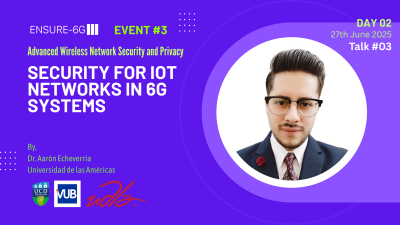As part of ENSURE-6G’s 3rd event, “Advanced Wireless Network Security and Privacy,” Dr. Henry Carvajal delivered a captivating presentation on “Enhancing security at the physical layer of wireless systems: applications in code-domain NOMA.” The talk explored how cutting-edge physical layer security (PLS) techniques, particularly in the context of Non-Orthogonal Multiple Access (NOMA), can bolster the security of future wireless networks.
6G and the Promise of Physical Layer Security
Dr. Carvajal began by situating 6G within a broader human-centered vision, emphasizing its role in achieving sustainable goals and fostering economic growth, beyond mere technological advancements [04:53]. Key enabling technologies for 6G include artificial intelligence, terahertz technologies, and cyber-physical security [05:38]. Within this landscape, Physical Layer Security (PLS) emerges as a transformative technology for the 6G physical layer [05:52].
The core objective of PLS is twofold:
- Reliability: Ensuring that legitimate users (Alice and Bob) can decode messages without error [07:27].
- Secrecy: Preventing unauthorized entities (Eve) from gaining information from the communication [07:37].
Understanding Non-Orthogonal Multiple Access (NOMA)
The presentation then transitioned to NOMA, a departure from the Orthogonal Multiple Access (OMA) used in 4G and early 5G, where users occupied distinct frequency or time resources [08:49]. NOMA allows multiple users to share the same resources, mitigating interference through multi-user detectors, and is crucial for achieving the massive connectivity envisioned for future networks (e.g., 1000 devices per cubic meter) [09:13, 09:29]. Dr. Carvajal specifically highlighted two types:
- Power Domain NOMA: Differentiates users by assigning different power levels [10:02].
- Code Domain NOMA (CD-NOMA): Distinguishes users through unique codes [10:12].
Sparse Code Multiple Access (SCMA) and Security Enhancements
The talk focused on Sparse Code Multiple Access (SCMA), a particular CD-NOMA technique. SCMA assigns codewords from multi-dimensional codebooks to different bit strings, enabling system overloading (more users than subcarriers) and utilizing an efficient multi-user detector [10:30, 11:27].
Dr. Carvajal’s research proposes a novel security enhancement for SCMA in an uplink system involving multiple users, a legitimate base station, and an eavesdropper [14:26]. The key innovation lies in generating codebooks from rotations of multi-dimensional MQAM constellations, where the optimal rotation angles are uniquely tied to the fading channel parameters of each user-base station link [15:07, 15:46].
The proposed security mechanism works as follows:
- Optimal rotation parameters can be computed by computationally capable user terminals or by the base station and then transmitted to users [17:54, 19:08].
- To protect this crucial information from eavesdroppers, a unique secret key is generated for each user based on the wireless channel’s inherent fading characteristics, specifically the channel phase [19:44, 19:57].
- These unique and random channel phases are then used to create chaotic sequences, which in turn determine the specific rotation parameter used for encoding and decoding from a pre-computed database [20:54].
Promising Results and Applications
Numerical results demonstrated that the proposed optimal rotation parameters significantly reduce the bit error probability for legitimate users [21:57]. Crucially, the eavesdropper experiences an extremely high bit error probability, rendering them unable to decode the user information, even with some channel estimation errors [24:11]. This robust strategy promises strong security against channel estimation inaccuracies [24:20].
In conclusion, NOMA, especially SCMA with these proposed security enhancements, presents a promising solution for IoT networks, aligning perfectly with 5G/6G goals of enhanced connectivity and efficient spectrum utilization [24:46]. The core of this innovative approach is the creation of user-specific, dynamic codebooks that remain unknown to potential eavesdroppers, ensuring both strong performance for legitimate users and robust secrecy.
This technology holds significant promise for scenarios demanding massive connectivity, such as industrial environments and intelligent cities, particularly for devices with lower bit rates and less stringent latency requirements [29:39, 30:32].
You can watch the full recorded talk here: Enhancing security at the physical layer of wireless systems: applications in code-domain NOMA



